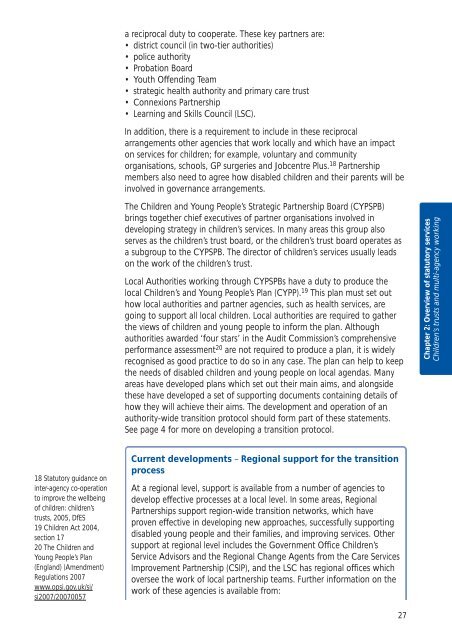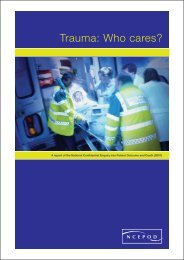A Transition Guide for All Services - Transition Information Network
A Transition Guide for All Services - Transition Information Network
A Transition Guide for All Services - Transition Information Network
- No tags were found...
You also want an ePaper? Increase the reach of your titles
YUMPU automatically turns print PDFs into web optimized ePapers that Google loves.
a reciprocal duty to cooperate. These key partners are:• district council (in two-tier authorities)• police authority• Probation Board• Youth Offending Team• strategic health authority and primary care trust• Connexions Partnership• Learning and Skills Council (LSC).In addition, there is a requirement to include in these reciprocalarrangements other agencies that work locally and which have an impacton services <strong>for</strong> children; <strong>for</strong> example, voluntary and communityorganisations, schools, GP surgeries and Jobcentre Plus. 18 Partnershipmembers also need to agree how disabled children and their parents will beinvolved in governance arrangements.The Children and Young People’s Strategic Partnership Board (CYPSPB)brings together chief executives of partner organisations involved indeveloping strategy in children’s services. In many areas this group alsoserves as the children’s trust board, or the children’s trust board operates asa subgroup to the CYPSPB. The director of children’s services usually leadson the work of the children’s trust.Local Authorities working through CYPSPBs have a duty to produce thelocal Children’s and Young People’s Plan (CYPP). 19 This plan must set outhow local authorities and partner agencies, such as health services, aregoing to support all local children. Local authorities are required to gatherthe views of children and young people to in<strong>for</strong>m the plan. Althoughauthorities awarded ‘four stars’ in the Audit Commission’s comprehensiveper<strong>for</strong>mance assessment 20 are not required to produce a plan, it is widelyrecognised as good practice to do so in any case. The plan can help to keepthe needs of disabled children and young people on local agendas. Manyareas have developed plans which set out their main aims, and alongsidethese have developed a set of supporting documents containing details ofhow they will achieve their aims. The development and operation of anauthority-wide transition protocol should <strong>for</strong>m part of these statements.See page 4 <strong>for</strong> more on developing a transition protocol.Chapter 2: Overview of statutory servicesChildren’s trusts and multi-agency working18 Statutory guidance oninter-agency co-operationto improve the wellbeingof children: children’strusts, 2005, DfES19 Children Act 2004,section 1720 The Children andYoung People’s Plan(England) (Amendment)Regulations 2007www.opsi.gov.uk/si/si2007/20070057Current developments – Regional support <strong>for</strong> the transitionprocessAt a regional level, support is available from a number of agencies todevelop effective processes at a local level. In some areas, RegionalPartnerships support region-wide transition networks, which haveproven effective in developing new approaches, successfully supportingdisabled young people and their families, and improving services. Othersupport at regional level includes the Government Office Children’sService Advisors and the Regional Change Agents from the Care <strong>Services</strong>Improvement Partnership (CSIP), and the LSC has regional offices whichoversee the work of local partnership teams. Further in<strong>for</strong>mation on thework of these agencies is available from:27
















